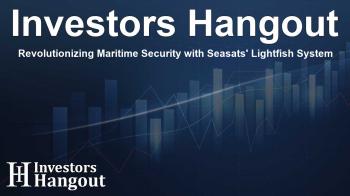Revolutionizing Maritime Security with Seasats' Lightfish System

Introducing the Lightfish Security System
Seasats, a prominent developer of autonomous maritime systems, has unveiled the Lightfish Security System. This advanced autonomous surface vehicle (ASV) is meticulously designed to meet the demands of intelligence, surveillance, and reconnaissance (ISR) missions in various environments such as coastal areas, harbors, and open oceans. The aim is to provide a robust tool for enhancing maritime domain awareness.
Enhancing Maritime Security
This innovative system is not just a vessel; it's a tool for addressing urgent operational needs in maritime security. The Lightfish can effectively monitor activities such as illegal fishing, smuggling, and other potential threats that can adversely affect maritime safety.
Specifications That Stand Out
The Lightfish Security System is characterized by its unique engineering. It features a solar-powered hull, which is complemented by an onboard generator and a lithium-ion battery system, enabling it to operate autonomously for several months at a time. This longevity is critical, allowing the vessel to track other ships undetected over significant distances. Furthermore, its design is non-ITAR, making it suitable for export and capable of being launched and recovered efficiently with minimal personnel.
Response from Industry Leaders
Tom Reynolds, Chief Strategy Officer at Seasats, underscores the practicality of such robotic platforms in maritime security. He emphasizes that if a platform is overly complex or expensive, it can hinder mission success despite performing well in demonstrations. Mike Flanigan, CEO of Seasats, highlights the importance of the Lightfish’s proven record of long-duration autonomous missions, which uniquely positions it to operate in busy or remote areas across various countries.
Applications and Capabilities
Seasats' Lightfish series has already seen successful deployment in collaborations with significant entities like the U.S. Navy and NOAA, proving its value in real-world scenarios. This Security System promotes a substantial upgrade in tactical ASV design, targeting both commercial and governmental sectors with a reliable, cost-effective solution in challenging maritime conditions.
Core Capabilities
The Lightfish is equipped with several advanced functionalities:
- Multi-modal communications including Starlink, Iridium, cellular, and MANET radio.
- A redundant sensor suite featuring marine radar, HD and thermal cameras, as well as AIS capabilities.
- An open systems architecture, allowing integrations with various third-party command and control platforms.
- A user-friendly interface that is accessible via secure tablets, laptops, or mobile devices.
- Rapid launch and recovery capability, achievable in less than 10 minutes using man-portable components without the need for larger vessels or cranes.
Technical Excellence
The specifications of the Lightfish reinforce its operational superiority:
- Length: 11.4 feet
- Endurance: Capable of multi-month operations
- Range: Over 6,000 nautical miles
- Cruise speed: 2.0 knots, max speed at 4.5 knots
- Power: 415W from solar, supplemented by a 100W generator
- Battery capacity: 4.0 kWh lithium-ion
- Operational capabilities: Functions effectively up to Sea State 6
- Additional payload support: Includes options for underwater acoustic monitoring and broadband VHF analysis.
About Seasats
Seasats is at the forefront of designing autonomous surface vehicles (ASVs) for extensive maritime applications in defense, scientific research, and commercial usage. Their flagship Lightfish series stands out by merging long-endurance capabilities with advanced sensor integration, all within a modular and economical frame. Supported by collaborations with leading defense contractors, Seasats has successfully delivered systems for critical maritime insight and oversight across the globe.
Frequently Asked Questions
What is the Lightfish Security System?
The Lightfish Security System is an autonomous surface vehicle designed for maritime surveillance and reconnaissance missions.
How does the Lightfish operate?
The vessel operates using a solar-powered hull combined with a lithium-ion battery and onboard generator, enabling long-duration operations.
What are the key applications of the Lightfish?
The Lightfish is used for monitoring maritime activities such as illegal fishing, trafficking, and ensuring security at ports.
Who can benefit from the Lightfish?
Both government agencies and commercial stakeholders can benefit from the low-cost, high-endurance solutions offered by the Lightfish.
What sets the Lightfish apart from competitors?
The Lightfish has a successful track record of autonomous missions and is designed for operation in both high-traffic and remote maritime environments.
About The Author
Contact Dominic Sanders privately here. Or send an email with ATTN: Dominic Sanders as the subject to contact@investorshangout.com.
About Investors Hangout
Investors Hangout is a leading online stock forum for financial discussion and learning, offering a wide range of free tools and resources. It draws in traders of all levels, who exchange market knowledge, investigate trading tactics, and keep an eye on industry developments in real time. Featuring financial articles, stock message boards, quotes, charts, company profiles, and live news updates. Through cooperative learning and a wealth of informational resources, it helps users from novices creating their first portfolios to experts honing their techniques. Join Investors Hangout today: https://investorshangout.com/
The content of this article is based on factual, publicly available information and does not represent legal, financial, or investment advice. Investors Hangout does not offer financial advice, and the author is not a licensed financial advisor. Consult a qualified advisor before making any financial or investment decisions based on this article. This article should not be considered advice to purchase, sell, or hold any securities or other investments. If any of the material provided here is inaccurate, please contact us for corrections.

